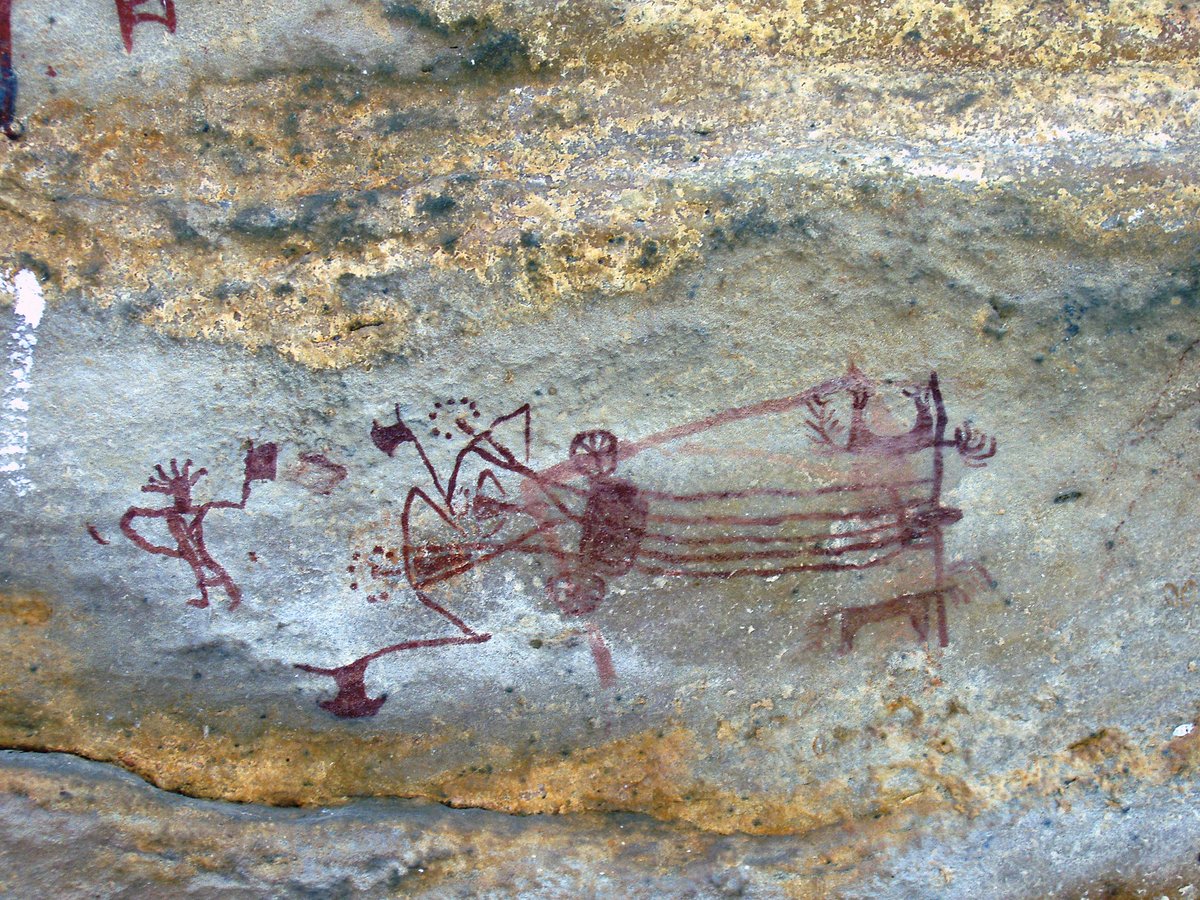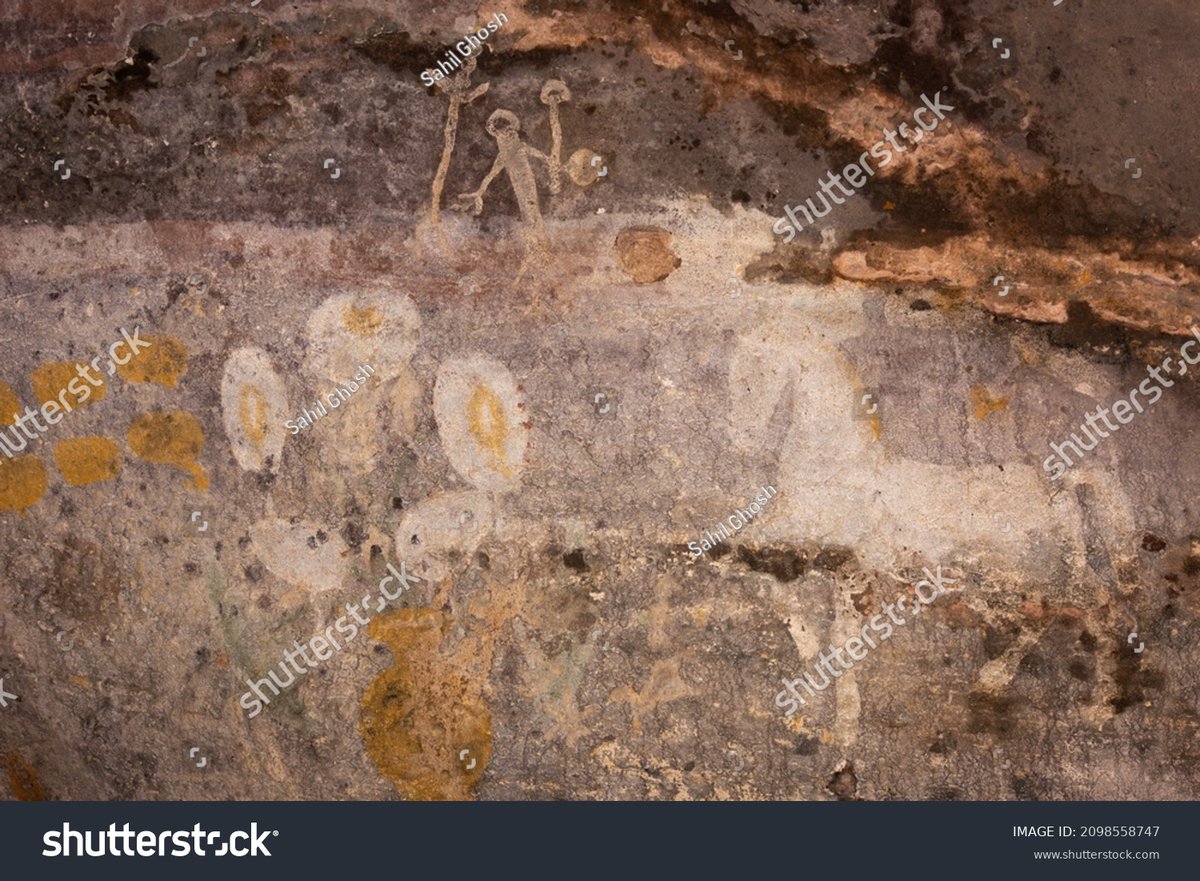#Thread Horse rock art from Chaturbhuj Nala caves Bhanpura, Pahadpur caves, Panchmadhi caves and caves from other parts of India.
The caves conservatively dates between 20,000-4000 ybp
#Archaeology
/1
The caves conservatively dates between 20,000-4000 ybp
#Archaeology
/1

Two horses decorated with garlands. The warriors can be seen holding curved swords, bow arrows and shields
Do they look like wild or domesticated?
Bhimbetka Cave Paintings
Bhopal in Madhya Pradesh
~4000 ybp
#Archaeology
bradshawfoundation.com/india/central_…
/2
Do they look like wild or domesticated?
Bhimbetka Cave Paintings
Bhopal in Madhya Pradesh
~4000 ybp
#Archaeology
bradshawfoundation.com/india/central_…
/2

This painting of horse and horse rider seems 2000-3000 years old
bradshawfoundation.com/india/central_…
#Archaeology
/3
bradshawfoundation.com/india/central_…
#Archaeology
/3

This one is my favourite
4 horses driven chariot driven by crowned man holding axe chased by a monster.
Could this be a folk story ?
#Archaeology
bradshawfoundation.com/india/central_…
/4
4 horses driven chariot driven by crowned man holding axe chased by a monster.
Could this be a folk story ?
#Archaeology
bradshawfoundation.com/india/central_…
/4

This Garrison with horses, witchcraft woman, crows,, Javelins from Bhimbetka is intriguing for similar art is decorated in North India during ahoi ashtami
en.m.wikipedia.org/wiki/Cave_pain…
#Archaeology
/5
en.m.wikipedia.org/wiki/Cave_pain…
#Archaeology
/5

Another troop of horses and horse riders in charge mode with Javelins from Bhimbetka caves
#Archaeology
/6
#Archaeology
/6
https://twitter.com/PradeepChande14/status/1595251881961353216

This 5000 years old art from Laddakh was pitched for UN seal.
The solo man and horse drawn on Laddakh rock is fascinating
#Archaeology
/7
The solo man and horse drawn on Laddakh rock is fascinating
#Archaeology
/7
https://twitter.com/GemsOfINDOLOGY/status/1594883630429798400
Relatively recent painting of horse on Bhimbetka caves seems divine.
#Archaeology
bradshawfoundation.com/india/central_…
/8
#Archaeology
bradshawfoundation.com/india/central_…
/8

Not sure of source of this solo horse and rider. But this could have been pitched for UN seal but it's attacking stance might fail it.
#Archaeology
/9
#Archaeology
/9

Rockart from Porivarai, Tamilnadu are self explanatory
#Archaeology
/12
#Archaeology
/12
https://twitter.com/GemsOfINDOLOGY/status/1502457881408700423

This Horse chariot from Bhimbetka has many stories to tell
#Archaeology
bradshawfoundation.com/india/central_…
/15
#Archaeology
bradshawfoundation.com/india/central_…
/15

This horsebfrom Panchmadhi is exquisite simply
#Archaeology
/16
#Archaeology
/16
https://twitter.com/GemofIndologies/status/1614228853618266112

3 person holding rein of 3 horses.
Does they look wild?
Dond district Uttarpradesh.
/17
Does they look wild?
Dond district Uttarpradesh.
https://twitter.com/_ekratt_/status/1629149688602689537?t=KlQGPXEA0TvKfPTeW-Qxjg&s=19
/17

I hope you've found this thread helpful.
Follow me @GemsOfINDOLOGY for more.
Like/Retweet the first tweet below if you can:
/18
Follow me @GemsOfINDOLOGY for more.
Like/Retweet the first tweet below if you can:
/18
https://twitter.com/GemsOfINDOLOGY/status/1629178979298189312
• • •
Missing some Tweet in this thread? You can try to
force a refresh





























